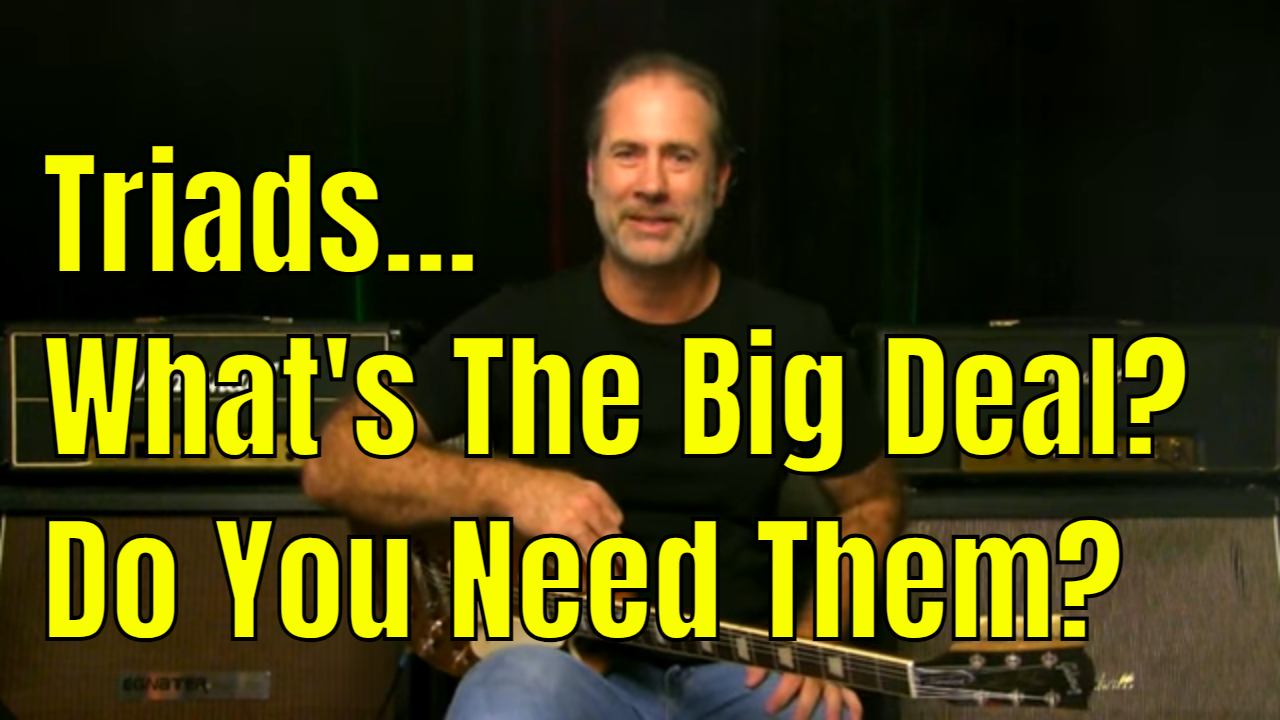It seems all I’ve heard about lately from other guitar teachers and students alike are triads…
But, what are triads?
Do you need them?
Will they help you in some way?
Why do you feel compelled to learn them (or should you?)
I’ll try and answer all of these questions in the video – but if I miss something, you know where the comments section is 😉

14 replies to "Triads, What’s The Big Deal?"
Excellent!! I perhaps dabble too much with different genre’s and instruments. Looking at dyads, triads, arpeggio’s, CAGED, little chords, SHR etc. really helped me connect the dots. Very useful even if not particularly leveraged for Blues!
Griff – I think you are an excellent teacher – but I think this lesson got bogged down in terminology…. I know about triads, arpeggios and CAGED, etc. I know they are different, and that if you want an extended chord, you need more notes than a triad will give you. But I think this wound up sounding more confusing and complex than it needed to. Just my impression.
Hey Griff,
It happens to all of us at some time or another: We get caught up in someone’s marketing hysteria!
You’re exactly right, it’s just like the CAGED hysteria from a few years ago. That one caused people to start forming polarizing opinions about it, like “I will NOT learn caged theory! WTF do I need that for?”
I’ve watched a few videos where they made it out as a “theory,” a “system of thought,” or even almost a religion.
But we all know it’s none of those! It’s just a way that the fretboard is organized, and it is very helpful to learn.
I have tried to explain in my comments in various videos like that: I’ll say, “Try not to focus on the word “caged,” (because of the way others used it in their comments. I think they felt like someone was trying to “cage them up.”)
Almost like with a cult. So they were fighting it, lashing out in a panic.
I always try to explain it this way:
“A “cage” isn’t only a trap, it can also refer to something to mount equipment on, much like a scaffold.”
“And, just like a scaffold, you can use it to build your knowledge of the fretboard, and how to find chords.”
At any rate, I think you did a good job of quieting down all the frantic people who basically don’t like to learn anything that they think “will be painful,” lol
Basically, I’ve told people the same thing to as you about triads: “Triads are just portions of the chords you already know,” and I also like “A triad is a chord, but a chord isn’t always a triad” (with examples like your gave).
So anyway, you handled it well!
I know those ” marketing hypes” can often be tiring because hysteria is what they’re trying to accomplish!
There are so many marketers who firmly believe that the only way to “stand out from the noise” is to be polarizing, insulting, obnoxious, or whatever. (They’re wrong, but that’s another topic!)
So, “Good job! “. (Pat yourself on the back, head, or wherever is your preference )
You fulfilled your mission as a great teacher!
Thanks.
I am a blind guitarist and visualise all chords and shapes inside my head rather than looking at my fingers. I visualise a three note triad but can see the difference between this opposed to playing the full chord or arppggio pattern. this was really useful for me and clarified the use between blues and more popular music. I now know how to build a solo using triads if not playing blues. I have often wondered why the blues scale would not quite sound right over simple major or minor chord progressions and in this scenario I could work with major or minor triads. this has really helped. thanks Griff!
The ‘little chords’ used in blues are either triads or diads and thus are useful to know how to construct and use them.
True, but I need to know how to play them, and I get that from practicing the chord shapes, not knowing the triads. Also, those chords come from 7th chords, which are not triads. When we remove a note or two, then yes, we are left with a smaller number that could be considered a triad or diad, but I’m not thinking about that and it doesn’t have any impact on how or what I play.
Totally agree with you. I personally love and use triads and diads frequently
Excellent lesson set
as always thanks Griff
This was helpful…. my takeaway is if your focus is blues, triads might be a fun diversion (such as “The Rolling Stones Move”), but aren’t likely a skill you need for playing the blues. Thanks for providing that perspective.
👍🏼
This might be people making something a lot more complicated than it is or thinking it is!
General definition of a triad
A triad is three things or people considered as one unit
Hence in musical terms three notes played together – however that is!
Great video Griff! I think the one other aspect of triads that you touched on with inversions and the harmonized major scale is intervals. Using triads as a vehicle for thinking about and using intervals and navigating the fretboard is an emphasis that I see people making. When you’ve got the triads down to the point where you see the interval shapes of major and minor thirds within the triads then it’s a small jump to seeing the tritone in the dom7 chords as an augmented 4th or diminished 5th and what that shape looks like on the fretboard.
You might find checking out Griff’s lessons on using intervals enlightening.
This is a fantastic explanation of triads, Griff. You could even say it’s Triassic. And that, of course, requires us to dig it.